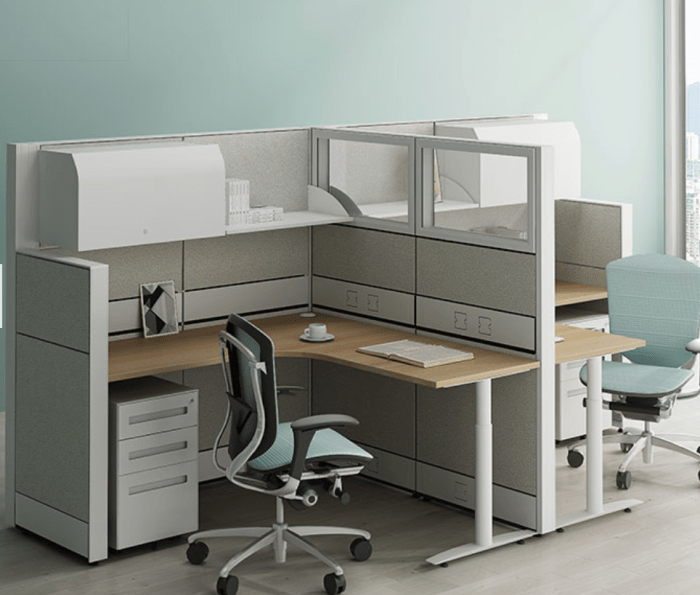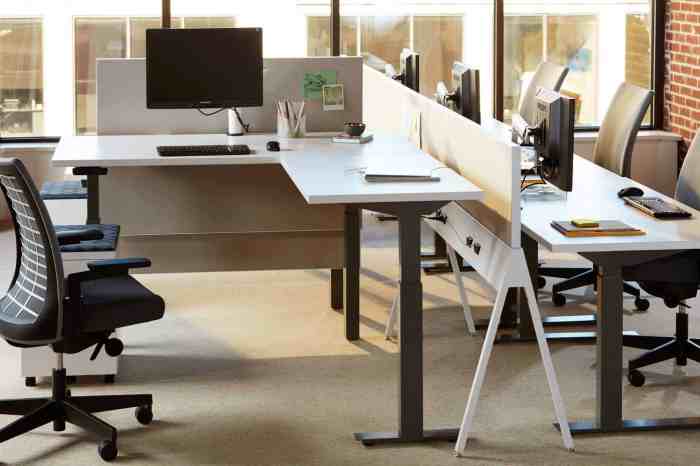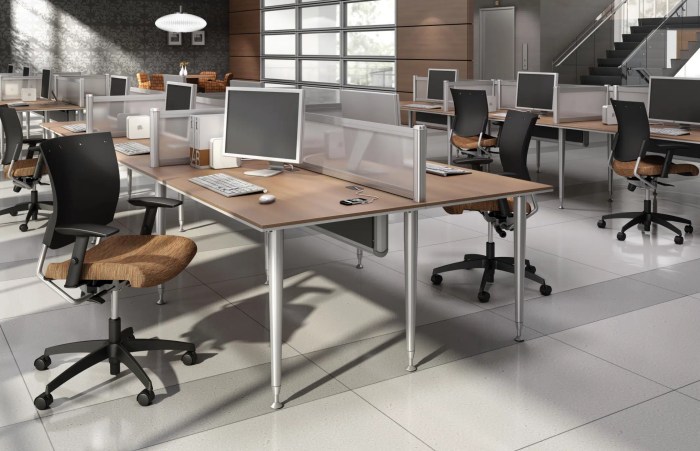Comfortable office furniture for workstations is crucial for employee well-being and productivity. Investing in ergonomic chairs, adjustable desks, and supportive accessories can significantly impact employee comfort, reducing strain and promoting a healthier work environment. This leads to increased focus, reduced absenteeism, and ultimately, a more positive and productive workplace. The right furniture choices can transform a typical office into a space designed for optimal performance and employee satisfaction.
This discussion will explore various aspects of comfortable workstation furniture, including the benefits of ergonomic design, the importance of adjustable features, and the various options available to suit different needs and budgets. We’ll also delve into the long-term cost savings associated with investing in quality, comfortable furniture and address common misconceptions surrounding ergonomic design.
Creating a comfortable and productive workstation is crucial for employee well-being and overall business success. Investing in comfortable office furniture is no longer a luxury; it’s a necessity. This comprehensive guide explores the key elements of comfortable workstation furniture, offering insights into chair ergonomics, desk design, and other essential components to optimize your workspace for comfort and productivity.
We’ll delve into various aspects, from the science behind ergonomic design to practical tips for choosing the right furniture for your needs.
Ergonomic Office Chairs: The Foundation of Comfort
The office chair is arguably the most important piece of furniture in a workstation. A poorly designed chair can lead to back pain, neck strain, and reduced productivity. Choosing an ergonomic chair involves considering several key features:
Key Features of an Ergonomic Office Chair:
- Adjustable Height: Allows you to position your feet flat on the floor and your thighs parallel to the ground.
- Lumbar Support: Provides crucial support for the lower back, preventing slouching and strain.
- Adjustable Armrests: Allow for proper arm positioning and reduce shoulder tension. Consider chairs with height and width adjustable armrests.
- Adjustable Backrest: Enables you to recline slightly, promoting better posture and reducing pressure on the spine.
- Headrest (Optional): Offers additional support for the neck and head, particularly beneficial for those who spend long hours seated.
- Breathable Fabric: Prevents overheating and discomfort during prolonged use. Mesh back chairs are popular for their breathability.
- Five-Star Base with Casters: Provides stability and easy maneuverability.
Investing in a high-quality ergonomic chair is a worthwhile investment in your health and productivity. Look for chairs that meet or exceed BIFMA standards for durability and safety. Consider brands known for their ergonomic designs, such as Herman Miller, Steelcase, and Humanscale.

Choosing the Right Desk for Your Workstation
The desk is the central hub of your workstation. Its design and height significantly impact your posture and comfort. Consider these factors when selecting a desk:

Types of Desks and Their Benefits:
- Standing Desks: Allow you to alternate between sitting and standing throughout the day, promoting better circulation and reducing sedentary behavior. These are increasingly popular for their health benefits and are often adjustable in height.
- Sit-Stand Desks: These desks offer the flexibility to seamlessly transition between sitting and standing positions. They are electrically or manually adjustable, offering personalized height settings.
- Traditional Desks: Offer a classic and stable workspace, but ensure the height is appropriate for your chair and body dimensions. Consider the desk’s depth and width to ensure sufficient space for your equipment and work materials.
- L-Shaped Desks: Provide ample workspace and are ideal for those who need more surface area. They can help organize your workspace effectively.
- Corner Desks: Maximize space utilization in smaller rooms and can create a more defined workspace.
Regardless of the desk type you choose, ensure it provides ample legroom and surface space for your needs. Consider the material – durable wood or laminate are popular choices.
Completing Your Comfortable Workstation: Accessories and Considerations
Beyond chairs and desks, several other accessories can enhance your workstation’s comfort and functionality:
Essential Accessories for a Comfortable Workstation:, Comfortable office furniture for workstations
- Footrest: If your feet don’t comfortably reach the floor when seated, a footrest can significantly improve posture and comfort.
- Monitor Arm: Allows you to adjust your monitor’s height and position, reducing neck and eye strain. This is crucial for proper posture and reducing strain.
- Keyboard Tray: Positions your keyboard and mouse at an ergonomic height, reducing wrist strain.
- Document Holder: Keeps documents at eye level, reducing neck strain.
- Ergonomic Mouse: Designed to fit comfortably in your hand and reduce wrist strain.
- Good Lighting: Reduces eye strain and improves overall comfort. Consider task lighting in addition to ambient lighting.
The Importance of Regular Breaks and Movement
Even with the most comfortable furniture, prolonged sitting can still have negative effects. Incorporating regular breaks and movement into your workday is crucial for maintaining health and productivity. Aim for short breaks every 30-60 minutes to stretch, walk around, or perform simple exercises.
Choosing the Right Materials for Your Office Furniture
The materials used in your office furniture significantly impact its durability, comfort, and overall aesthetic. Consider the following:
Popular Materials and Their Pros and Cons:
- Wood: Durable, aesthetically pleasing, but can be expensive and heavy.
- Metal: Durable, sturdy, and often more affordable than wood, but can feel cold and less aesthetically pleasing to some.
- Laminate: Affordable, durable, and easy to clean, but can be less aesthetically pleasing than wood.
- Mesh: Breathable and comfortable for chairs, but may not be as durable as other materials.
Frequently Asked Questions (FAQs)
- Q: How much should I spend on an ergonomic chair? A: The cost of ergonomic chairs varies widely, from a few hundred to several thousand dollars. Consider your budget and needs when making a purchase. Look for quality features rather than focusing solely on price.
- Q: How do I know if my chair is the right size? A: Your feet should be flat on the floor, your thighs parallel to the ground, and your back comfortably supported. Adjustability is key.
- Q: What is the best type of desk for a home office? A: The best type of desk depends on your space, budget, and preferences. Consider your workflow and whether you prefer a standing or sitting desk.
- Q: How often should I replace my office chair? A: The lifespan of an office chair depends on its quality and usage. However, replacing your chair every 5-7 years is generally recommended for optimal comfort and support.
- Q: Are standing desks worth the investment? A: Standing desks can be beneficial for health and productivity, but they’re not for everyone. Consider your individual needs and preferences before investing.
Resources: Comfortable Office Furniture For Workstations
- Ergonomics Society
- Occupational Safety and Health Administration (OSHA)
- Business and Institutional Furniture Manufacturers Association (BIFMA)
Call to Action
Investing in comfortable and ergonomic office furniture is a vital step towards improving your well-being and productivity. Take the time to research and choose furniture that meets your specific needs and preferences. Your comfort and health are worth the investment! Contact us today to explore our range of high-quality ergonomic office furniture.

Query Resolution
What are the key features of an ergonomic chair?
Key features include adjustable lumbar support, armrests, and seat height; breathable fabric; and a contoured seat and back for proper spinal alignment.
How do I know what size desk is right for me?

Consider your workspace needs, the type of work you perform, and available space. A general rule is to allow ample room for your monitor, keyboard, mouse, and other necessary items, with comfortable space to move around.
What are the benefits of using a standing desk?

Standing desks promote better posture, increased energy levels, and can reduce back pain associated with prolonged sitting. They encourage movement throughout the workday.
